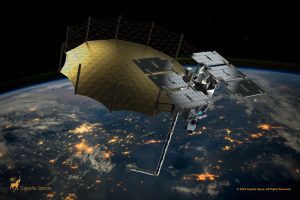It is an AFWERX Ventures Strategic Funding Increase (STRATFI) award. AFWERX is part of the U.S. Department of the Air Force (DAF) and works with the Air Force Research Laboratory (AFRL). It is described as an innovation programme, an accelerator involving commercial companies addressing DAF challenges.
Capella Space
Capella Space says the funding will be used “to mature, scale and extend” its SAR technology. Specifically, it says the STRATFI investment will speed the development of its next-generation SAR sensor. Key features of the new sensor, apparently requested by SAR users, include dual-polarization operation and lower latency delivery.
SAR polarimetry will improve feature detection and classification across a wide range of applications, says the company, including defense, agriculture, environmental monitoring, and disaster response.
“As the first American commercial SAR imagery provider, we are excited to continue developing our leading technology to support the U.S. Air Force and its partners,” said the CEO of Capella Space, Frank Backes. “This award will further accelerate Capella’s mission to deliver SAR data that is consistently high-quality, timely and reliable.”
SAR
An advantage of synthetic aperture radar – compared to typical optical imagery – is that it enables day-night, all-weather imaging. Basically, penetrating atmospheric conditions.
It can be described as a type of active data collection, where a sensor records the amount of energy that is reflected back to it, making it responsive to surface characteristics, such as building structures and atmosphere moisture.
It is a “synthetic” aperture in the sense that a sequence of data acquisitions from a shorter antenna are combined to simulate what would be much larger antenna.
Mention was made of being the first American commercial SAR imagery provider, as the Tokyo-based Synspective and the Finnish ICEYE are among the competitors in this field.
Last year, Capella Space raised $60m in funding from the United States Innovative Technology Fund (USIT). The San Francisco headquartered company said it would use the capital to expand its imaging capacity and develop new data products around its SAR imagery and analytics capabilities. For example, it had three new analytics offerings for Vessel Detection, Change Detection and Global Change Monitoring.
See also: AFWERX funds LeoLabs radar tech for security in space

